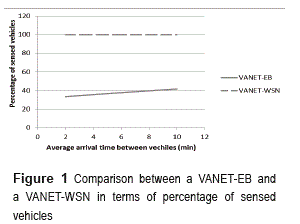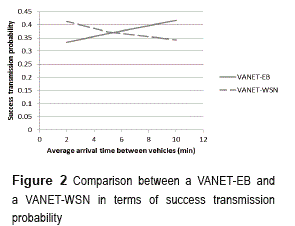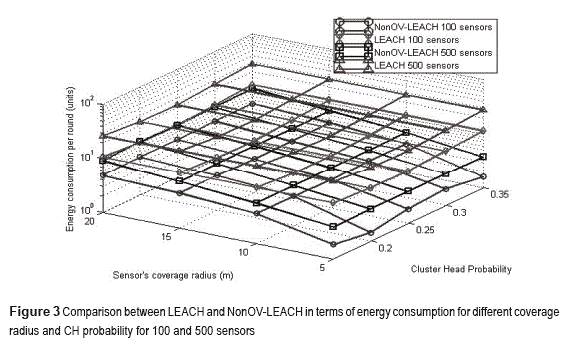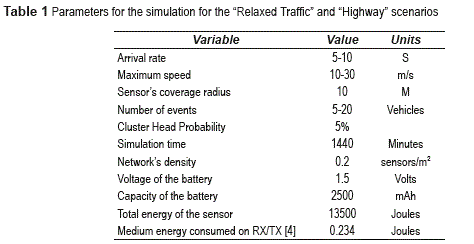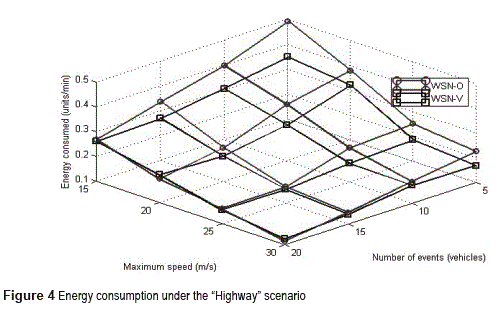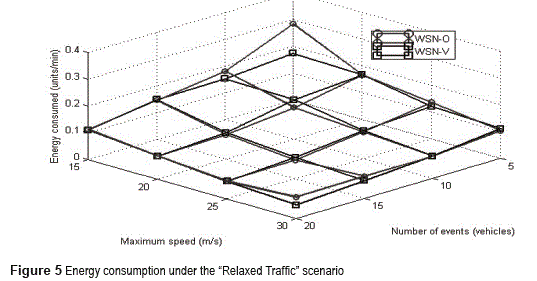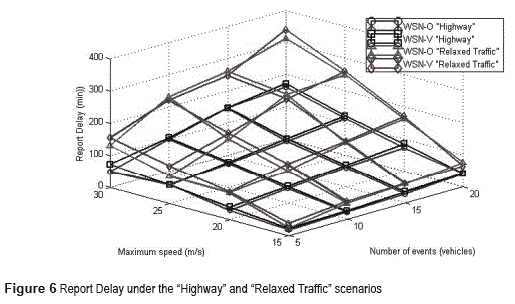Serviços Personalizados
Journal
Artigo
Indicadores
-
 Citado por SciELO
Citado por SciELO -
 Acessos
Acessos
Links relacionados
-
 Citado por Google
Citado por Google -
 Similares em
SciELO
Similares em
SciELO -
 Similares em Google
Similares em Google
Compartilhar
Revista Facultad de Ingeniería Universidad de Antioquia
versão impressa ISSN 0120-6230
Rev.fac.ing.univ. Antioquia no.71 Medellín abr./jun. 2014
ARTÍCULO ORIGINAL
Monitoreo de trá fico vehicular en sistemas V2I mediante el uso de una red inalámbrica de sensores
Vehicular traffic monitoring in V2I systems using a wireless sensor network
Mario A. Ramírez Reyna1, Mario E. Rivero Angeles2* , Iclia Villordo Jimenez1
1Academa de Telemá tica, Unidad Profesional Interdisciplinaria en Ingenierí as y Tecnologí as Avanzadas del Instituto Polité cnico Nacional (UPIITA-IPN). La Laguna Ticomá n, Gustavo A. Madero. CP. 07340. Mé xico DF., Mé xico.
2Laboratorio de Comunicaciones y Redes de Computadoras, Centro de Investigació n en Computació n del Instituto Polité cnico Nacional (CIC- IPN). Av Juan de Dios Bá tiz, Esq. Miguel Othó n de Mendizá bal S/N, Nueva Industrial Vallejo, Gustavo A. Madero. CP. 07738. Mé xico DF, Mé xico.
*Autor de correspondencia: teléfono: + 52 + 771 + 2857281, correo electrónico: mriveroa@ipn.mx (M. Rivera)
(Recibido el 13 de julio de 2013. Aceptado el 20 de marzo de 2014)
Resumen
En un futuro cercano la mayoría de los sistemas automotores confiarán fuertemente en el intercambio de información entre vehí culos o a la infraestructura, para mejorar las condiciones de manejo, incrementar la seguridad o simplemente intercambiar información entre los usuarios. Esta es la razón por la cual hoy en día la investigación y desarrollo de una Red Ad-Hoc Vehicular es muy importante. En este documento se presenta un diseño y análisis de una Red Ad-Hoc Vehicular (VANET) con la asistencia de una Red Inalámbrica de Sensores (WSN) activada por eventos para el monitoreo de tráfico en una autopista. La WSN mencionada está basada en el protocolo LEACH, sin embargo, una modificación clave es propuesta con el propósito de incrementar el tiempo de vida de la red para aplicaciones sobre VANETs. La idea básica es reducir al mínimo la superposición de áreas entre grupos vecinos y de esta manera disminuir la redundancia y contar con una mejor cobertura de supervisión en la autopista, con un menor costo de transmisión. Adicionalmente, se proponen dos métodos diferentes para el reporte de eventos. En el primero, la información del trá fico es transmitida exclusivamente entre los nodos en la WSN, mientras que el segundo método hace uso de los vehículos para retransmitir la información al concentrador. Los métodos propuestos son analizados en términos del consumo de energía y retardo promedio de reporte.
Palabras clave: Monitoreo orientado a eventos, monitoreo de tráfico, clustering, VANET, WSN, mecanismos de transmisión de información, consumo de energía
Abstract
In the near future the majority of the automotive systems will strongly rely on the exchange of information among vehicles or infrastructure to improve the driving conditions, increment security or simply have access to internet and entertainment services. This is the reason why the research and development of Vehicular Ad-Hoc Networks is very important nowadays. In this paper, a design and analysis of a Vehicular Ad-Hoc Network (VANET) assisted by an event driven Wireless Sensor Network (WSN) for traffic monitoring in a highway is presented. The aforementioned WSN is based on the well- known LEACH protocol. However, a key modification is proposed in order to increase the network lifetime for applications on VANETs. The basic idea is to minimize the overlapping areas among neighboring clusters in order to reduce redundancy and to have a better coverage of the supervised highway with a lower transmission cost. Additionally, two different methods for the event reporting are proposed. In the first one, the traffic information is transmitted exclusively among the WSN nodes, while the second method makes use of the vehicles in order to relay the information to the sink. The proposed methods are analyzed in terms of energy consumption and average report delay.
Keywords:Event driven reporting, traffic monitoring, clustering, VANET, WSN, information transmission mechanisms, energy consumption
Introduction
In recent years, there has been an increasing number of vehicles in the streets and highways of major cities around the world. Additionally, advancements in computer technology have produced safer, comfortable and more efficient vehicles. However, the rise in the road accidents and traffic congestion are highly costly [1]. In this way, the use of wireless communications has been considered an alternative to reduce both issues. In this context, Vehicular Ad-Hoc Networks (VANETs) have been intensively researched lately in order to implement Intelligent Transportation Systems (ITS). VANETs are organized networks, defined by its high mobility continuous change in its topology and restricted by the road and the driver behavior.
The general idea is that each vehicle transmits relevant information about both, internal (like average speed for example) and external (report about the traffic flow, weather, etc.) operation conditions to communicate all vehicles in the road and relay this information to a traffic management center. The use of VANETs allows the introduction of new services mainly oriented to improve the driving conditions, such as accident prevention messages, traffic congestion avoidance, traffic density sensing and also entertainment oriented services such as internet access, file sharing, multimedia files download, among others. To this end, 75 MHz in the 5.9 GHz band has been assigned for Dedicated Short Range Communications (DSRC) to exchange messages for Vehicles to Vehicles (V2V) and Vehicles to Infrastructure (V2I) with a range of 1000 m approximately. DSRC is a two way wireless communication protocol that is used to support Intelligent Transport Systems (ITS) and considers the use of On-Board Equipment (OBE) as the Vehicle Infrastructure Integration (VII) and the Roadside Equipment (RSE) with strategic location, that allow high data transmissions [2]. In the literature, most of the published studies focus on V2V systems and the V2I systems have been largely overlooked. Of special interest is the analysis of the performance of the communication system in terms of the traffic load (number of packets per second transmitted in the network) and communication efficiency (number of successful packet transmissions between vehicles and the infrastructure) of V2I networks. In this work, the deployment of a Wireless Sensor Network (WSN) as the infrastructure network to monitor the driving conditions in a highway environment is proposed and studied. Specifically for high speed and low vehicle densities, the packet traffic load is low since there are not many vehicles exchanging information and the communication efficiency is also expected to be low since the average time that the vehicle is connected to the RSE is very low. Conversely, for slow speed and high vehicle densities, the packet throughput is expected to be high. However, the communication efficiency is expected to be also low due to the high number of collisions in the random access protocol. The energy consumption in a VANET is usually not considered to be of major importance because vehicles have enough energy to maintain communications of wireless devices connected to the vehicle's battery. The principal reason to consider a WSN is to increase the communication efficiency for traffic monitoring in highways for V2I systems. Wireless Sensor Networks are scattered self-organized networks composed by many tiny nodes with restricted memory, processing capabilities and in general powered by batteries. Since once the energy is depleted in a node it is no longer useful, WSNs have a short life span compared to other wireless networks. When a specific number of nodes have drained all their energy (50% or 70% for example), the WSN is no longer functional because the information cannot be retrieved. The main purpose of these networks is to gather information about its surroundings and aggregate it in a sink node for further analysis. Combinations of various techniques are needed in order to optimize the energy consumption and to grant a higher life span. In particular, the grouping of nodes in clusters (clustering) has been proven to be an efficient way to reduce energy consumption [3-5]. It is important to note that the implementation of nodes in a road may not be straightforward since nodes have to be placed in such a way as to detect the presence of vehicles. For instance, nodes can be placed in the middle of the road or by the side. This would entail placing the nodes manually inside the asphalt. On the other hand, nodes can be placed randomly by placing them inside the asphalt before it is placed on the road. In any case, additional costs have to be considered for the practical implementation of the WSNs. However, the benefits of such system greatly overpasses conventional traffic monitoring systems as it is shown in the following. Due to the complexity of this topic, we leave this research lines for future work.
In this work the use of a clustered-based event driven reporting WSN as a RSE on a V2I system for traffic monitoring is proposed and studied through simulations. As previously stated, the principal design parameter in the WSN is the energy consumption that determines the network's lifetime. As such, a clustering scheme called NonOV-LEACH based on the LEACH protocol is used for the information aggregation and transmission to the sink node. In NonOV-LEACH the cluster overlapping is drastically reduced which also decreases energy consumption as it is explained in detail later in this study.
The sensor nodes that conforms the WSN will be scattered on the road in order to capture information from the vehicles that passes over them. The relevant information for such traffic monitoring is the vehicle identification number (ID) and its current speed. This data is sent to Base Stations (EB) for further analysis. In this context, an event is considered to be the detection of a vehicle in the system, i.e., when a vehicle is detected, the sensor nodes register the ID and the time of detection. When a given number of events are detected, nodes transmit this information to the BS. Two different mechanisms for the information relay are proposed and studied using discrete event simulation tools:
• WSN-Only (WSN-O): In this mechanism, the sensor nodes gather information of a certain number of events and form clusters based on the modified LEACH protocol. At this point the event related data is transmitted to the cluster heads (CHs), which are the nodes regulating the access in each cluster, and from the cluster heads to the BS. This is a mechanism that only makes use of the WSN.
• WSN-Vehicle (WSN-V): In this case, the clusters are formed and the event reports are transmitted as in the WSN-O mechanism. However, the cluster heads do not transmit directly to the BS. Instead, the gathered information is transmitted back to a passing vehicle and it in turn transmits it to the BS. In this proposal, there are no direct large- range transmissions from the cluster heads to the BS and it is assumed that the distance between them are much lower than to the BS directly.
Note that there is no difference on the practical implementation of these strategies, since in both cases a WSN has to be deployed as well as the APs by the side of the road. Building on this, the benefits of using a WSN for traffic monitoring compared to a classical V2I system are as follows: a) The use of hundreds of nodes in a specific location compared to one RSE increases the communication efficiency since vehicles remain longer in the coverage area of the network and many nodes detect their presence (ID and speed for instance); b) Since the WSN is in charge of measuring the traffic flow, vehicles no longer have to communicate this data using DSRC channels; c) A WSN has more probability of reading a vehicle's information than a single RSE as shown in figure 1, where VANET-EB corresponds to the case where only one access point is used and VANET-WSN is the case where a WSN is used as the infrastructure; d) If the number of RSEs is increased, the probability of sensing a vehicle also increases but the probability of success message transmission is reduced since the collision probability among RSEs increases. This is shown in figure 2. Hence, the bandwidth is better used for intra-vehicle communications or alarm reporting.
The rest ofthe paper is organized as follows: First, we present the system model and assumptions used throughout the paper. Following this, the proposed clustering algorithm and the V2I system are clearly described. Then, relevant numerical results are presented. Finally, the paper concludes with a summary of the conclusions and contributions.
Development
Vehicular traffic model
The traffic model considered in this work is the Exponential Model of R. T. Underwood, which models the free flow of vehicles in a given lane of a highway or in a city. It can be used in the context of different grades of congestion. Equations (1) and (2) govern the behavior of this model:

where k is the current vehicle density in a given lane, kc is the maximum density supported in the lane, and vl is the maximum speed in the system. In (1) it is possible to see that if the actual density of vehicles is the maxim density supported in the lane (k→ kc), then the velocity that will have the new vehicles entering the system will be about a third of the maxim velocity allowed in the way (vl).
In the work ofArdekani, Ghandehari and Nepal [7]some tests were conducted in order to corroborate the behavior of this model with other models. The results obtained show that the exponential model of Underwood, closely matched the traffic conditions in the city of Dallas, Texas. Different mobility models can be considered in a future work in order to evaluate the system's performance under different conditions.
System model
In this section, the system variables and assumptions are described in detail. The simulations developed in this work are discrete events simulations on Java. The following variables are considered:
• Maximum speed. This parameter refers to the maximum speed that a vehicle will have on the road. The actual speed of the vehicle is given by the exponential model presented in [6-7].
• Arrival rate. It refers to the average number of vehicles per second arriving to the WSN. Arrivals to the system are considered to follow a Poisson process.
• Number of events. It refers to the number of vehicles that are detected by the system in order to initiate the clustering algorithm for the event reporting to the BS.
• Network's density. It is defined as the number of sensors per unit of area. An increment on the density of the network impacts the cluster formation procedure since it increases the formation time, decreases the probability of success packet transmission and thus increases the energy consumption.
• Sensor 's coverage radius. It delimits the transmission range of each sensor node. If the radio transmission is increased, the clustering process takes more time since more nodes have to contend for the access to the medium which in turn increases the collision probability and the energy consumption.
• Cluster head probability. This parameter refers to the percentage of the sensors that become Cluster Heads (CH).
As stated before, two methods to gather the information provided by the WSN are proposed:
a) WSN-O. Once the CH aggregates the information it sends the information to the Base Station.
b) WSN-V: In this case, once the CH aggregates the information it sends it to the nearest vehicle, which transports the information to the next base station.
The performance parameters considered in this study are energy consumption and cluster formation time (which is related to the reporting latency) as function of the aforementioned variables for the next scenarios that we considered to be environments found in a practical system:
a)Relaxed traffic. This scenario consists on a freeway under a relaxed traffic condition maintaining a moderate value of maximum speed (40-60 km/h) and a low arrival rate (10 min. between vehicles).
b) Highway. This scenario consists on a highway maintaining a high value of maximum speed (90-120 km/h) and a moderate arrival rate (5 min. between vehicles).
Proposed wsn for traffic monitoring in a vehicular environment
In this section, the proposed clustering protocol is presented. First, the LEACH protocol is discussed in detail for the purpose of clearly explain the proposed modifications in order to increase the system's lifetime.
Low Energy Adaptive Clustering Hierarchy (LEACH)
The LEACH protocol [8]groups sensors into clusters in order to conserve energy. To balance the energy consumption inside the network, the CH role is rotated among all sensor nodes. CHs are selected in a fully distributed manner, without needing the exchange of signaling messages, which are required for the CH announcement. The local decision to become a CH takes into account when the node served as a CH for the last time. As such, a sensor node that has not been a CH for a long period is more likely to become a CH in the next round. Each sensor node selected as a CH, transmits an accepting message to the remaining sensor nodes. Cluster members (CMs) that receive multiple CH announcements select the CH that requires the lowest energy for communication by sending a cluster join message. Once a CH received all the CM announcements, it computes its schedule and assigns time slots to the different CMs. Hence, a TDMA frame shared among CMs is formed. Each CM can enter the sleep mode during the TDMA frame and wakes up only at its associated slots. Instead, the CH never enters the sleep mode and at the end of each TDMA frame it transmits the aggregate data to the sink node. The LEACH operation is composed therefore of two phases: set-up and steady state phases. While the set- up phase refers to cluster formation, the steady phase corresponds to the TDMA operation. The network administrator fixes the duration of the steady phase. It is generally preferred that the steady phase lasts much longer than the set-up phase in order to limit the energy consumption due to the coordination message overhead. However, rotation of the CH role among the sensor nodes is needed to balance the energy consumption inside the WSN.
The LEACH protocol has the advantage of being simple and achieves a good system performance. However, for vehicular traffic monitoring applications, it is not well suited. First, LEACH is designed for small surveillance areas since it is consider that in the cluster formation phase, all nodes contend among each other. Hence, very costly transmissions are made at this point. Second, since LEACH does not guarantee a uniform distribution of clusters in the system, it is possible to have several CHs concentrated in a small region of the network, i.e., cluster overlapping can occur with a relatively high probability. In small surveillance areas, this is not very energy consuming since the distance form CMs to CHs that are relatively separated is not very high. However, in vehicular applications where the surveillance area is of many kilometers, this can be a very important energy wastage issue. Therefore, in order to practically implement this clustering protocol, a modified version of LEACH has to be designed. Hence, we propose the so called NonOV-LEACH protocol as means of achieving a commercial-efficient clustering scheme.
NonOV-LEACH
Based on the LEACH algorithm we propose the following modifications in order to implement the LEACH protocol in big areas such as those in VANETs environments:
• The transmission radius of each sensor is limited by a certain value. This reduces the energy consumption at the cluster formation phase specially when the final distribution of CHs in the network is such that a certain number of CMs find the nearest CH at a large distance. This restriction on the transmission radius prevents nodes from draining their energy in these environments.
• Cluster overlapping is reduced. LEACH does not guarantee that CHs are evenly distributed in a WSN. In a highly dense network this conveys higher energy consumption due to the contentions caused by the diverse sensors trying to use the channel in the same area.
• Uncovered zones are avoided. LEACH has not the problem of uncovered areas. However, due to the limited transmission radius, this now becomes a problem as some areas of the WSN become disconnected from the rest.
The NonOV-LEACH algorithm that is proposed in this paper works in the following manner:
1. Initiate NonOV-LEACH in the network whenever the number of events (number of detected vehicles passing over the WSN) is met.
2. If a sensor is neither a CH nor a CM (a sensor may not belong to a cluster because of the limited coverage radius proposed in NonOV- LEACH) re-initiate NonOV-LEACH in the area surrounding that sensor (the surrounding area is given by the coverage area of the sensor).
3. Stop the algorithm until every sensor near the area that initiates NonOV-LEACH is a CM or a CH.
This mechanism is restricted to the following conditions: the percentage of nodes that act as Cluster Head must be 35% or lower and the transmission radius must be in the range of 5 m to 20 m. Through extensive simulations it has been observed that for these parameters the proposed NonOV-LEACH achieves better results than LEACH. The rationale behind this is based on two principles: 1) the transmission radius provides the number of sensors that form the cluster in a region (a larger radius generate more nodes in a cluster) and 2) because of the re-initiation of the algorithm, if the sensor is neither CH nor CM with higher Cluster Head Probabilities the number of clusters that are formed is higher. Hence, there is higher energy consumption and higher packet traffic at the network. For the rest of the paper, the parameters mentioned above are used.
Simulation results
In this section, some relevant numerical results to study the proposed V2I system are presented for a surveyed area of 3.5 km. Figure 3 shows the energy consumption of both LEACH and NonOV-LEACH for 100 and 500 nodes in the network for a no traffic environment (no vehicles transiting the road). It can be seen that the NonOV-LEACH for 100 sensors achieves up to two orders of magnitude lower energy consumption. The same results are obtained for 500 nodes but in a lesser extent. From these results, it can be seen that as the transmission radius increases, the energy consumption increases. This is due to the fact that more nodes content to gain access to the shared channel increasing the collision probability. As such, each transmission consumes more energy.
For the average cluster formation time for both LEACH and NonOV-LEACH, the NonOV- LEACH provides much lower average cluster formation time: for the LEACH protocol, it is in the order of 0.008 sec., while the NonOV- LEACH of 0.0004 sec. for all values of transmission radius and 100 nodes and 0.02 and 0.001 sec. for LEACH and NonOV-LEACH respectively for 500 nodes in the system. This is because in the NonOV-LEACH, there is a higher success probability that allows a faster cluster formation due mainly to the lower number of nodes contending for the channel at the cluster formation phase. For the performance evaluation of the WSN-O and WSN-V for the information relay to the sink, we study two different scenarios previously mentioned. The parameters used for these simulations are shown in Table 1.
In order to calculate the life span of the system we use the information obtained from the sensors Mica2 and Imote specified in [4]and the characteristics of a standard lithium battery.
The results obtained from these simulations show that under these conditions, the system's life span ranges from some months to about two years depending on the number of events to form a cluster and the maximum speed of vehicles. Note that this lifetime can be further incremented using compression and/or aggregation techniques that are considered outside the scope of this work. However, consider that in the specific case of Mexico City, the asphalt is usually changed every year to 18 months. As such, a system lifetime of two years is considered to be acceptable. In the case of other cities in the world that change the asphalt in longer time spans, different solutions can be employed. For instance, the use of solar energy or the energy found in electromagnetic waves in the environment can be used to power the nodes. In figures 4 and 5, it is shown that as the number of events required to initiate the cluster formation increases, the energy consumption decreases. This is because the cluster formation is a very energy consuming process.
Also, it can be seen that the maximum speed that vehicles have in the system has an important impact on the WSN's lifetime. Specifically, higher speeds convey to higher energy consumption because more sensors are activated for each passing vehicle. On the other hand the Report Delay (figure 6) caused by the restrains of the network is lower for the WSN-O than WSN-V. This is because in order to transmit the information from the WSN to the BS in the WSN-V mechanism, a vehicle is required. Hence, it is not guaranteed that the BS would be inside the coverage range of this relaying vehicle at any given time. As such, the mobile has to move until the BS is found in order to transmit the information. These results were obtained using one Lithium AA battery as reference.
It can be seen that the WSN-V mechanism achieves in general, lower energy consumption. The rationale behind this is that it avoids long- range transmissions to the BS. However, the complexity increases since vehicles have to receive this information from the WSN.
From these set of results it is clear that the use of a WSN as means of the infrastructure in a V2I environment is feasible. In particular, the WSN-V mechanism provides the best results in terms of energy consumption for all traffic conditions. On the other hand, the WSN-O achieves slightly lower reporting delay compared to the WSN-V strategy as seen in figure 6.
Conclusions
This work has focused on the impact of a V2I system assisted by an event driven WSN for the information gathering of traffic conditions in a road. A clustering protocol, NonOV-LEACH, based on the well-known LEACH protocol is proposed and studied. The NonOV-LEACH protocol avoids clustering overlapping by limiting the transmission radius of nodes. This proposed clustering protocol renders much lower energy consumption in vehicular environments for relaxed traffic scenarios. It is shown that by enabling the NonOV-LEACH protocol, the WSN's life span can reach close to a year without compre ssion and/or aggregation techniques. Two mechanisms to relay the information to the sink by means of the WSN are proposed and studied. As the main contribution of this study, we show that a V2I system is feasible and can be used as an alternative to only single separated RSEs. Specifically, the WSN-V strategy achieves lower energy consumption with slightly higher reporting delay. Hence, this strategy would be more suited for VANETs under the V2I paradigm. Finally consider that this study is a preliminary study on the use of WSNs in V2I systems for traffic monitoring applications. Much work is still needed in order to have a commercial practical system. For instance, the placement of the nodes in the road is challenging task as well as a more efficient power feed to the nodes other than typical batteries. The use of alternative energy sources have to be considered in this context, such as solar energy.
References
1. H. Trivedi, P. Veeraraghavan, S. Loke, H. Phuong, J. Singh. A Survey of Lower Layer Technologies for Vehicle-to-Vehicle Communication. Proc. IEEE Malaysia International Conference on Communications. Kuala Lumpur, Malaysia. 2009. pp. 441-446. [ Links ]
2. M. Nekoui, A. Eslami, H. Pishro. The Capacity of Vehicular Ad Hoc Networks with Infrastructure. 6th International Symposium on Modeling and Optimization in Mobile, Ad Hoc. Wireless Networks and Workshops. Berlin, Germany. 2008. pp. 267-272. [ Links ]
3. I. Akiyldiz, W. Su, Y. Sankarasubramaniam, E. Cayirci. ''A Survey on Sensor Networks.'' IEEE Commun. Mag. Vol. 40. 2002. pp. 102-114. [ Links ]
4. K. Kredo, P.Mohapatra. ''Medium Access Control in Wireless Sensor Networks.'' Comput. Netw. Vol. 51. 2007. pp. 961-994. [ Links ]
5. L. Wang, Y. Xiao. ''A Survey of Energy-efficient Scheduling Mechanisms in Sensor Networks.'' Mobile Netw. Appl. Vol. 11. 2006. pp. 723-740. [ Links ]
6. R. Underwood. Speed, Volume, and Density Relationships: Quality and Theory of Traffic Flow. Pennsylvania State University, University Park, USA. 2004. pp. 141-188. [ Links ]
7. S. Ardekani, M. Ghandehari, S. Nepal. ''Macroscopic Speed-Flow Models for Characterization of Freeway and Managed Lanes.'' Institutul Politehnic din Iasi. Buletinul. Sectia Constructii. Arhitectura Vol. 57. 2011. pp. 140-160. [ Links ]
8. W. Heinzelman, A. Chandrakasan, H. Balakrishnan. ''An Applications Specific Protocol Architecture for Wireless Microsensor Networks.'' IEEE Transactions on Wireless Communications. Vol. 1. 2002. pp. 660-670. [ Links ]













